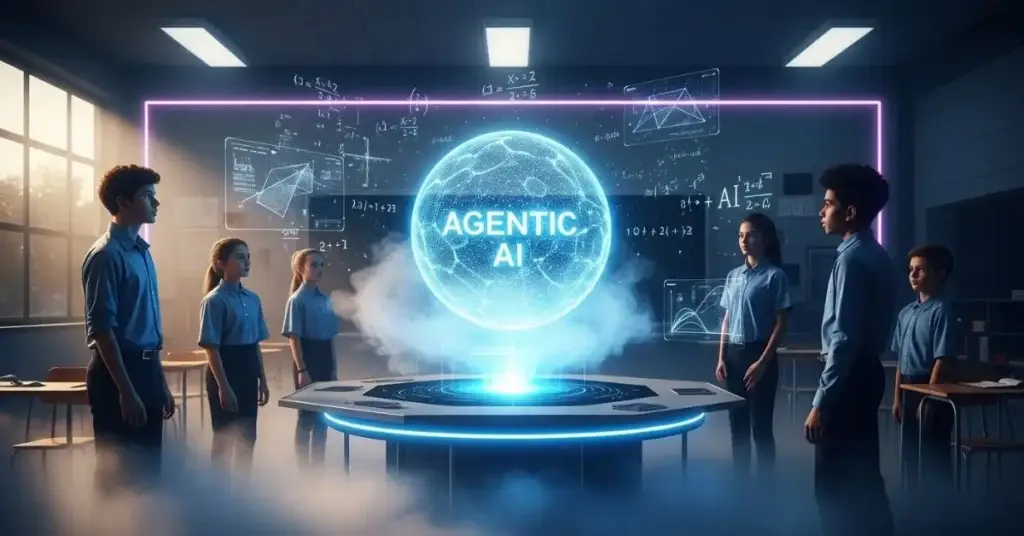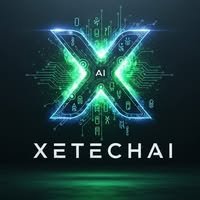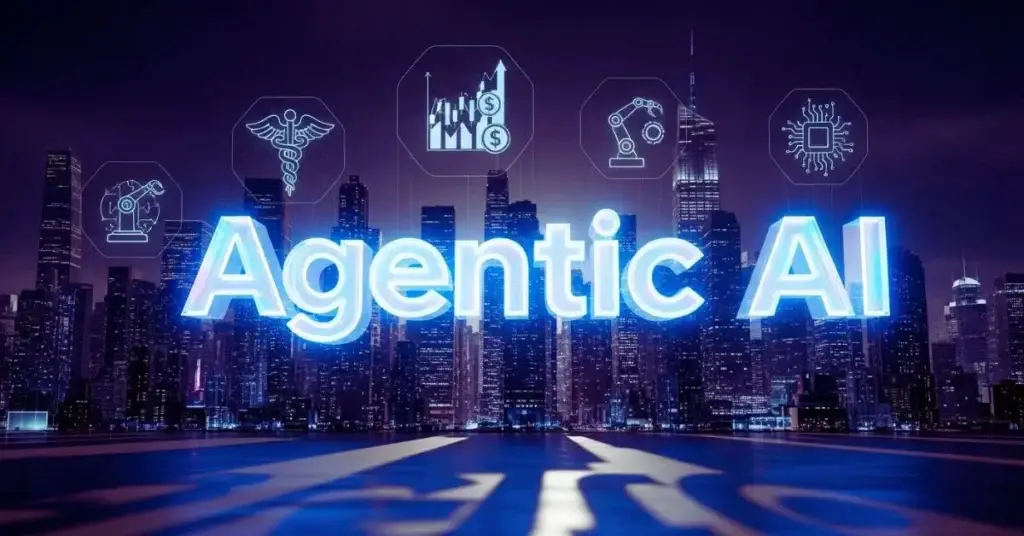
Introduction
Agentic AI in Education is no longer a futuristic buzzword. In 2025, schools and universities across the USA and Canada are actively testing and integrating AI systems that go beyond answering questions,
They act like proactive learning partners. From personalized tutoring to predictive analytics, agentic AI transforms how students learn, teachers teach, and education systems prepare learners for the future.
What is Agentic AI and Why is It Important for Education?

Agentic AI refers to autonomous artificial intelligence systems that can make decisions, plan tasks, collaborate with humans, and adapt proactively. Unlike traditional AI tools that wait for user prompts, agentic AI can:
- Reflect on functions and improve their own performance
- Adapt dynamically to changing learning conditions
- Collaborate with teachers, students, and other AI agents
- Learn proactively over time to become more effective
In education, this shift is massive. Instead of simply answering a student’s math question, an agentic AI system can:
- Design entire practice exams
- Track progress and learning gaps
- Suggest curriculum updates
- Act as a “co-learner” in group projects
This makes education more personalized, efficient, and engaging, especially in the USA, where schools seek scalable solutions to support diverse learners.
Key Frameworks Driving Agentic AI in Education
Researchers in the USA and globally are developing structured frameworks to guide how agentic AI should function in learning environments.
Agentic Workflow for Education (AWE)
- Focuses on self-reflection, tool use, task planning, and multi-agent collaboration.
- Case study: AI-generated math test items performed as reliably as human-written questions, showing how AI can support large-scale assessment.
From Passive Tool to Socio-Cognitive Teammate
Defines AI’s evolution in classrooms:
- Adaptive Instrument
- Proactive Assistant
- Co-Learner
- Peer Collaborator
This progression shows how AI moves from being a “calculator” to becoming a team member in learning environments.
ARCHED Framework (Human-Centred AI)
- Keeps teachers central in AI adoption.
- Aligns AI tasks with Bloom’s taxonomy (remembering, applying, creating).
- Ensures AI empowers rather than replaces educators
MOSAIC Framework for Collaborative AI
- promotes multi-agent collaboration in group projects.
- Example: Multiple AI systems working with students to create presentations, research summaries, or experiments.
Real-World Use Cases of Agentic AI in the USA & Canada
AI Tutors and Adaptive Learning
- AI tutors adjust lessons based on student speed and comprehension.
- Platforms like Khan Academy’s Khanmigo (powered by GPT-4) are already being piloted in US classrooms.
- Students get personalized study paths and instant feedback.
Automated Assessments and Feedback
- AI generates quizzes and exam questions.
- Companies like Pearson and ETS are testing AI-driven essay grading with human oversight.
- Saves teachers’ hours of manual grading.
Student Retention and Support Systems
- AI detects “at-risk” students early by analyzing attendance, grades, and engagement.
- Colleges in the USA are piloting systems that alert advisors when a student is likely to drop out.
Teacher and Administrative Assistant
- Automates grading, progress tracking, and scheduling.
- Suggests new resources for teachers to use in lessons.
- Reduces administrative workload so teachers can focus on mentoring.
Miracles of Agentic AI in Education
- Personalized Learning: Tailored lesson plans, quizzes, and pathways.
- Reduced Teacher Workload: Less grading and more focus on mentorship.
- Real-Time Analytics: Instant insights into performance and engagement.
- Improved STEM Preparedness: Supports the USA and Canada’s workforce goals for AI-driven jobs.
- Scalable Support: Can be deployed across urban and rural schools.
These education-focused use cases are only one side of the story. Agentic AI is also redefining industries, businesses, and society at large.
Discover the bigger picture in our article: Why Agentic AI is the Next Big Leap in AI Revolution.
Challenges and Risks of Agentic AI
- Ethical Concerns & Privacy
- Student data collection raises security risks.
- Biased datasets may lead to unfair outcomes.
- Teacher Oversight
- AI cannot replace teacher judgment.
- Oversight is essential for balanced decision-making.
- Cost & Scalability
- Many schools lack the resources to implement advanced AI.
- Infrastructure upgrades are required.
- Trust & Transparency
- Teachers and parents want explainable AI.
- Black-box AI models create scepticism.
Impact on Different Education Levels
K–12 Schools
- AI tutors provide one-on-one support where teachers cannot.
- Helps identify struggling students earlier.
Higher Education
- Universities use AI for research assistance, grading, and predictive analytics.
- Example: MIT pilots AI agents in collaborative engineering projects.
Parents & Guardians
- Home-based AI learning tools personalize after-school learning.
- Reduces dependency on expensive private tutoring.
Expert Opinions & Industry Insights
- MIT Technology Review highlights agentic AI as the “next evolution of classroom AI.”
- EdSurge reports that US teachers find AI tutors helpful but stress the need for ethical safeguards.
- The US Department of Education is exploring frameworks for responsible AI adoption by 2030.
Future of Agentic AI in Education (2025–2030 Vision)

- Hybrid classrooms: AI + teacher collaboration becomes the norm.
- Policy frameworks: Stronger rules on data privacy and ethics.
- Peer AI collaborators: AI as group project partners.
- STEM acceleration: More focus on AI-ready workforce preparation.
Agentic AI in Education is reshaping the learning landscape in the USA and Canada. By combining autonomy, proactive adaptation, and collaborative intelligence, it has the power to make classrooms more personalized, efficient, and future-ready. While privacy, ethics, and cost challenges remain, the potential benefits from personalized tutoring to retention improvement are too powerful to ignore.
The future isn’t about replacing teachers but empowering them with AI teammates. Education leaders across North America must act now to adopt agentic AI responsibly and prepare students for the AI-driven world ahead.
FAQs: Agentic AI in Education
1. What is Agentic AI in Education?
Answer: Agentic AI in Education means AI systems that don’t just wait for commands but act like proactive teammates. They can plan tasks, adapt lessons, and collaborate with students and teachers. This makes learning more personalized and effective.
2. How does Agentic AI differ from Generative AI or ChatGPT?
Answer: Generative AI, like ChatGPT, produces content when prompted. Agentic AI in Education, however, goes further, it sets goals, reflects, and adapts independently. Instead of just answering, it guides students through learning paths.
3. What are real-world examples of Agentic AI being used in US classrooms?
Answer: Schools in the USA are piloting AI tutors like Khanmigo, automated essay grading systems from Pearson, and AI dashboards that track student progress. These tools show how Agentic AI in Education is already reshaping learning.
4. Can Agentic AI replace teachers or reduce their role?
Answer: No. Agentic AI in Education is built to support teachers, not replace them. AI can automate grading and adapt lessons, but teacher oversight, empathy, and mentorship remain irreplaceable.
5. How does Agentic AI personalize learning for students?
Answer: Agentic AI creates custom lesson plans, quizzes, and study tips based on student performance. For example, if a student struggles with algebra, the AI slows down, offers extra practice, and tracks progress in real time.
6. What are the risks and ethical concerns of using Agentic AI in schools?
Answer: Some risks include:
- Privacy concerns from student data collection
- Bias in AI datasets leading to unfair outcomes
- Overreliance on AI by students
That’s why USA schools are focusing on ethical frameworks and transparency.
7. How much does it cost to implement Agentic AI in education?
Answer: Right now, advanced Agentic AI in Education platforms can be costly, especially for public schools. However, costs are expected to drop as adoption grows, making AI more accessible across the USA.
8. Is Agentic AI safe and trustworthy?
Answer: Yes, but only when used responsibly. Agentic AI in Education requires teacher oversight, ethical guidelines, and explainable systems so parents and schools can trust how decisions are made.
9. How does data privacy work with Agentic AI in schools?
Answer: In the USA, laws like FERPA regulate student data. Responsible AI systems anonymize data, encrypt records, and give parents and teachers control over how information is used.
10. What skills do students need to use Agentic AI effectively?
Answer: Students should develop:
- AI literacy (understanding how AI works)
- Critical thinking (not accepting all AI answers blindly)
- Digital responsibility (ethical use of tools)
These skills ensure Agentic AI in Education empowers rather than limits learners.
11. How will Agentic AI impact standardized testing and grading?
Answer: AI can generate practice exams, provide instant essay feedback, and detect plagiarism. While Agentic AI in Education makes grading faster, final decisions still need teacher validation for fairness.
12. Can Agentic AI help with student retention and support at-risk learners?
Answer: Yes. Many US colleges use AI to detect students with low attendance, declining grades, or disengagement. Agentic AI systems send alerts to advisors, helping schools intervene early and improve retention rates.
13. What does the future of Agentic AI in K-12 vs Higher Education look like?
Answer:
- K–12 Schools: Personalized tutoring, adaptive lessons, AI class assistants
- Higher Education: Research collaboration, advanced analytics, AI-supported projects
By 2030, Agentic AI in Education will be standard in US classrooms, creating human + AI hybrid learning models.


